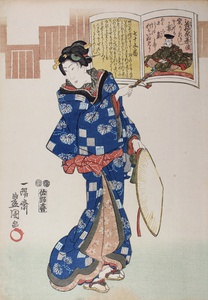| Method | Woodblock (nishiki-e) |
| Artist | Utagawa Kunisada (Toyokuni III) (1786-1865) |
| Published | 1847–52 (Kôka 4–Kaei 5) |
| Dimensions | Ôban tate-e [~15.6 x 10.7 inches] |
| Notes |
Series: Hyakunin isshu eshô: A Pictorial Commentary on One Hundred Poems by One Hundred Poets Signed: Ichiyôsai Toyokuni ga Censor seal: Muramatsu, Yoshimura Publisher: Sanoya Kihei (Kikakudô) Plate number 75 from the series Hyakunin isshu eshô: One Hundred Poems by One Hundred Poets. This scene shows a bijin (beauty) in full-length kimono. She is pointing to an open book on the right with a pipe. Kunisada (also known as Toyokuni III) was the most popular, prolific and financially successful designer of ukiyo-e woodblock print in 19th-century Japan. In his own time, his reputation far exceeded that of his contemporaries, Hokusai, Hiroshige and Kuniyoshi. The artist started his career as a pupil of Toyokuni I whose name he adopted in 1844 as Toyokuni III. Almost from the first day of his activity, to the time of his death in 1865, Kunisada was a trendsetter in the art of the Japanese woodblock print. Always at the vanguard of his time, and in tune with the tastes of the public, he continuously developed his style, which was sometimes radically changed, and did not adhere to stylistic constraints set by any of his contemporaries. He was not only a brilliant print maker but also an excellent business man who had great commercial success. Following the traditional pattern of the Utagawa school, Kunisada's main occupation was kabuki and actor prints, and about sixty percent all of his designs fall in this category. Notable students of his include Toyohara Kunichika, Utagawa Sadahide and Utagawa Kunisada II. Condition: Some toning to sheet. Laid to paper. |
| Framing | mounted |
| Price | £300.00 |
| Stock ID | 51240 |

